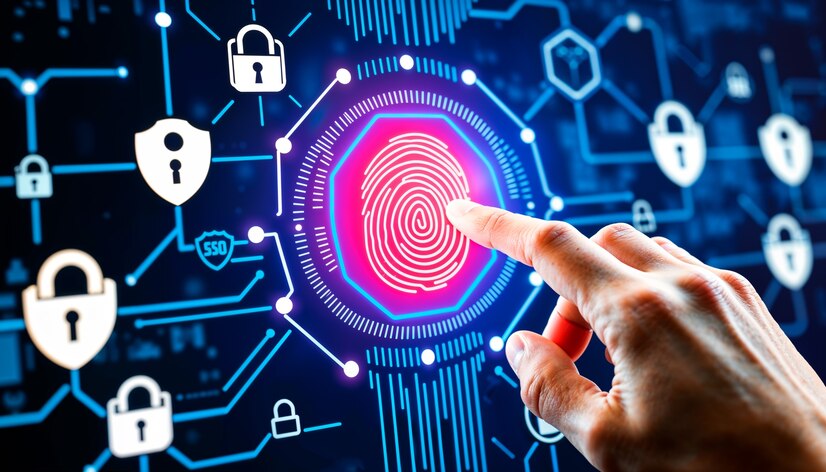A biometric system works by capturing and analyzing unique biological traits, such as fingerprints or facial features, to authenticate a person’s identity. This technology uses advanced algorithms to convert the biometric data into a digital code, which is then compared to a stored template to determine a match.
Biometric systems are commonly used for access control, time and attendance tracking, and identity verification in various industries. Biometric systems have gained popularity due to their accuracy, speed, and convenience. They offer a reliable way to ensure secure access and authentication, reducing the risk of unauthorized entry or identity fraud.
The use of biometrics has expanded to a wide range of applications, including smartphone unlocking, airport security, and border control. As technology continues to advance, biometric systems are expected to play an increasingly significant role in enhancing security and streamlining processes across different sectors.

The Basics Of Biometric Systems
In today’s digital world, biometric systems have become increasingly prevalent in various facets of society. These sophisticated technologies are designed to authenticate individuals based on their unique physical or behavioral traits. By leveraging these distinctive characteristics, biometric systems provide a secure and efficient method for identity verification, access control, and authentication.
Definition And Purpose Of Biometric Systems
Biometric systems are technology-based solutions that utilize an individual’s unique biological or behavioral traits to verify their identity. These traits can range from fingerprints and facial recognition to iris patterns and voiceprints. The primary purpose of biometric systems is to accurately and securely authenticate individuals, eliminating the need for traditional methods such as passwords or physical keys.
Examples Of Biometric Technologies
There are various forms of biometric technologies that are widely used across different industries. Some prominent examples include:
- Fingerprint Recognition: This technology analyzes the unique patterns and ridges present on an individual’s fingers to verify their identity.
- Facial Recognition: By capturing and analyzing facial features, this technology can identify and authenticate individuals.
- Iris Recognition: The intricate patterns of the iris are used to accurately confirm a person’s identity, making it an effective biometric method.
- Voice Recognition: This technology analyzes the vocal characteristics of an individual to confirm their identity, offering a convenient and secure authentication method.
Understanding Biometric Authentication
Principles Of Biometric Authentication
Biometric authentication is a method of verifying an individual’s identity based on their unique physiological or behavioral characteristics. It works on the principle that everyone has distinct biometric traits that can be used to establish their identity securely. The process involves capturing, comparing, and analyzing these biometric traits to grant access or authorization.
Types Of Biometric Authentication Methods
Biometric authentication methods utilize different traits for identification and verification. Some of the most commonly used biometric authentication methods include:
- Fingerprint recognition
- Facial recognition
- Retina or iris scanning
- Voice recognition
- Hand geometry
- Behavioral biometrics (such as typing rhythm or gait analysis)
Biometric System Components
Biometric system components are crucial elements that work together to authenticate and verify individuals based on their unique physiological and behavioral characteristics. These components include sensors and data acquisition, feature extraction, and the matching process. Each component plays a key role in the overall functionality of a biometric system, ensuring accurate and secure identification.
Sensors And Data Acquisition
Sensors are the primary components of a biometric system that capture the unique biological or behavioral traits of individuals. These sensors are designed to acquire data such as fingerprints, facial features, iris patterns, voice patterns, and more. Through high-resolution imaging and advanced data acquisition techniques, biometric sensors ensure the accurate capture of unique physical characteristics.
Feature Extraction And Matching Process
Feature extraction involves the identification and extraction of distinctive features from the captured biometric data. It focuses on isolating specific elements that are unique to an individual, such as fingerprint ridge patterns, facial landmarks, or iris texture. Once the features are extracted, the matching process compares the extracted features with the stored reference templates to verify the identity of the individual. Advanced algorithms and pattern recognition techniques are used to analyze and compare the extracted features, enabling reliable and precise identification.
How Does A Biometric System Work?
Biometric systems are complex security solutions that rely on unique physical and behavioral characteristics to verify a person’s identity. These systems are increasingly being used in various industries, from law enforcement to personal devices, due to their accuracy and security. Understanding how a biometric system works is crucial to comprehend its functionality and potential applications.
Capture Of Biometric Data
One of the primary functions of a biometric system is the capture of biometric data. This involves gathering unique physiological or behavioral characteristics of an individual, such as fingerprints, facial features, iris patterns, voiceprints, or even gait analysis. Specialized biometric sensors or devices are used to collect this information, ensuring high accuracy and reliability.
Processing And Storage Of Biometric Data
After the biometric data is captured, it undergoes intricate processing and storage within the biometric system. The collected information is converted into digital format using algorithms, and various mathematical models are applied to analyze and extract unique patterns or features. This processed data is then securely stored within the biometric system, often using advanced encryption methods to prevent unauthorized access.
Biometric System Integration
Biometric system integration refers to the incorporation of biometric identification technologies into existing security or access control frameworks. By seamlessly integrating biometric systems with other security solutions, organizations can enhance their overall security and streamline identity verification processes.
Applications Of Biometric Systems In Various Industries
Biometric systems are extensively utilized across diverse industries for secure and convenient identity authentication. Here are some key applications of biometric systems:
- Financial Services: Biometric systems are used in banking and finance for secure customer authentication during transactions and access to sensitive financial information.
- Healthcare: In the healthcare sector, biometric systems help in ensuring accurate patient identification, secure access to medical records, and monitoring the presence of authorized personnel in restricted areas.
- Retail: Biometric systems enhance security in retail environments by enabling efficient employee attendance monitoring and preventing unauthorized access to inventory or restricted areas.
Security And Privacy Considerations In Biometric Systems
While biometric systems offer advanced security features, it’s crucial to address potential privacy concerns and security implications. Some key considerations include:
- Privacy Protection: Biometric data must be securely stored and processed to prevent unauthorized access or misuse, ensuring user privacy and compliance with data protection regulations.
- Security Measures: The integration of biometric systems should incorporate robust encryption techniques and measures to safeguard biometric templates and authentication processes against unauthorized access and fraudulent activities.
Frequently Asked Questions For How Does A Biometric System Work?
How Does Biometric Device Work?
A biometric device works by scanning and analyzing unique physical or behavioral characteristics such as fingerprints or facial features to verify a person’s identity. The device then matches the biometric data with stored information to grant access. This process enhances security and eliminates the need for traditional passwords or keys.
How Does A Biometric Verification System Work?
A biometric verification system works by scanning unique physical characteristics like fingerprints or facial features to verify identity. The captured data is compared against stored records to grant or deny access. This technology ensures secure and reliable identification for various applications.
What Are Three Steps Used By Biometric Systems?
Biometric systems use three steps: First, they capture the biometric data of an individual. Next, the system processes and stores this data securely. Finally, during verification or identification, it compares the newly captured data with the stored data to authenticate the individual.
What Is The Basic Principle Of Biometric Systems?
Biometric systems authenticate individuals based on unique physical or behavioral characteristics. These systems use fingerprints, iris scans, or facial recognition to verify identity.
Conclusion
Biometric systems benefit various industries by providing secure and efficient authentication processes. With the advancements in technology, biometric systems continue to evolve, offering enhanced security measures and user-friendly interfaces. As organizations prioritize data protection, the integration of biometric systems is becoming increasingly prevalent in various sectors.
